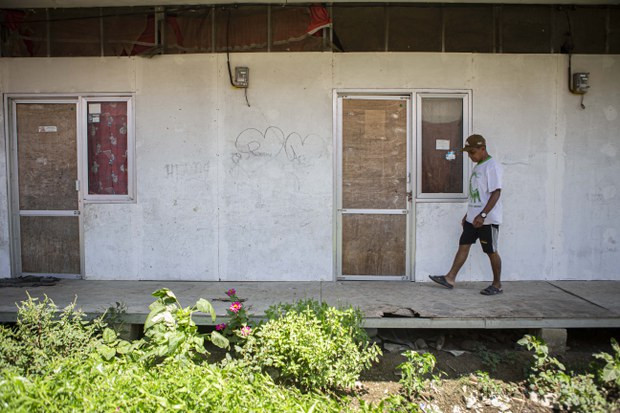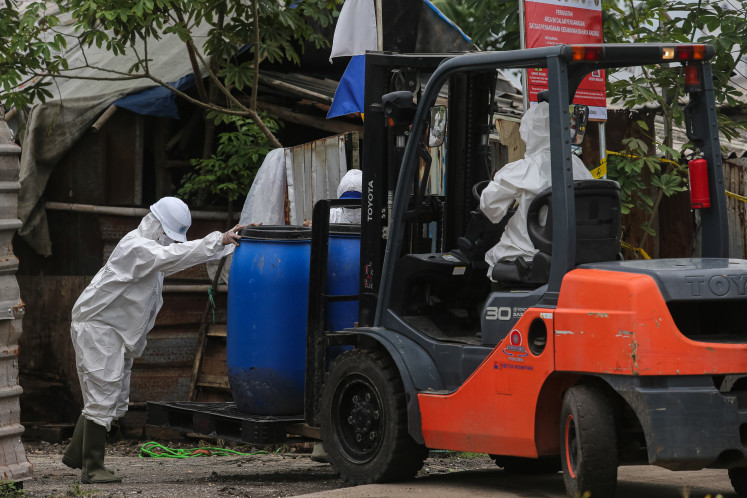Popular Reads
Top Results
Can't find what you're looking for?
View all search resultsPopular Reads
Top Results
Can't find what you're looking for?
View all search resultsFive years on, thousands of Palu quake survivors still live in shelters
Fewer than half of total of 7,682 permanent houses have been built as authorities claim land-acquisition issues caused the delay.
Change text size
Gift Premium Articles
to Anyone
A
cherry tree stands out among the rows of shabby shelters in Petobo, a village in Central Sulawesi’s capital of Palu that was once swallowed by the earth.
Its green canopy offers a refuge for the survivors of the earthquake and tsunami that ravaged the area five years ago, as they gather to share their stories and frustrations.
“There is no clarity on when we will move to a permanent house. Just now, there was another census of shelter residents by the government. It’s the usual annual census,” Abdul Naim, a resident of the shelters, told BenarNews.
Abdul, 37, is among about 2,500 people who are still living in temporary accommodation in Petobo on the outskirts of Palu, waiting for the government to fulfill its promise of permanent housing.
The shallow magnitude 7.5 quake and tsunami, which struck on Sept. 28, 2018, killed more than 4,600 people and displaced more than 220,000. Many of the victims were killed when their homes were sucked under by torrents of mud, in a process called liquefaction where water-logged soil turns into quicksand.
One of the worst-hit areas was Petobo. There, the residents witnessed their homes, belongings and loved ones being swept away.
As Central Sulawesi prepares to mark the fifth anniversary of the disaster, some survivors are still living in 12-square-meter temporary shelters, each shared with up to six people.
Inside, walls are cracked and broken, some floors are leaking and some toilets are damaged. The residents also face problems with clean water and electricity supply.
The government built the Petobo shelters in 2019 for people who lost their homes in the disaster. The residents moved in during the emergency-response period.
The Public Works and Housing Ministry had planned to use the shelters for one to two years, but none of the 655 permanent houses for evacuees being built in Petobo are finished.
“Look at our condition in this shelter: the rooms are small, hot, and the material is damaged,” Naim said. “We have conveyed all our complaints to the government, but there is no response.”
To make ends meet, most residents work odd jobs, such as construction workers or scrap collectors. Others who still have farmland or livestock continue farming.
Lukman Tenggo, 57, the leader of the Petobo Shelter Neighborhood Association, said he did not think survivors would get permanent houses this year.
“We can’t move there until the construction is finished, including the road and other public facilities,” he told BenarNews. “The construction process is only around 70 percent done. It may take until 2024 for people to move.”
He is worried about the houses’ quality.
“They say the houses are earthquake resistant, but the construction appears shaky,” Lukman said. “We will live in those houses forever, so they have to be strong.”
‘No excuses’
Only 3,463, or 45 percent, of the total 7,682 permanent houses needed for the survivors have been built, according to the Central Sulawesi Disaster Management Agency. About 1,330 families are still living in temporary shelters and have not received permanent housing, the agency said.
“When the permanent houses are finished, all families in shelters have to move,” the agency's head of rehabilitation and reconstruction, Budi Yunus, told BenarNews. “Now we just have to wait for the completion of the construction.”
Land-acquisition issues caused the delay, Budi said.
“Some of the land was only released last year by the government,” he said. “That’s why the construction only started this year. Land was the problem but now everything has been sorted out.”
The provincial administration set aside Rp 10 billion (US$646,000) to buy land for permanent houses in Petobo.
Central Sulawesi Legislative Council Speaker Nilam Sari Lawira expressed concerns that some residents still lived in shelters.
“We agreed to give Rp 55 billion in grant assistance for land acquisition for Palu, Sigi and Donggala in the revised 2021 budget,” she said, referring to the areas worst hit by the twin disaster.
“So, there are no more excuses about land acquisition because the central government will build directly when the local government provides the land.”
Nowhere to go
Despite the hardships of living in the temporary shelters, the families have no choice but to stay.
Mulyadi Hasan, 53, another resident of Petobo, said his house was destroyed by the earthquake and liquefaction.
“If I leave the shelter, where else can I live with my family?” he said.
Hasan recounted how he and his family ran for their lives when the earthquake struck. Afterward, the ground he stepped on turned into mud and moved in several directions. Everything on top of it was destroyed.
He said he was grateful they survived, but he still felt haunted by the memories of that day. “If I think about what happened, it seems impossible that we are still alive,” he said.
Besides a house, he also had several motorcycles. But when the disaster came, everything was gone.
“Nothing was left. My family and I who survived only had clothes on our backs,” he said.










